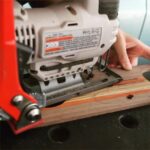Are you a woodworker looking to protect your clothes and stay organized during your projects? If so, learning how to make a woodwork apron is the perfect solution. In this article, we will cover the importance of wearing a woodwork apron, its benefits to woodworkers, and provide a step-by-step guide on how to create one for yourself.
Wearing a woodwork apron is essential for any woodworker as it serves as a protective barrier between the body and potential hazards in the workshop. Not only does it keep clothes clean from sawdust, stains, and splinters, but it also provides convenient storage with pockets for tools and other essentials. Additionally, wearing an apron can contribute to better organization and efficiency during woodworking sessions.
To get started on making your own woodwork apron, you will need specific materials such as fabric and straps, as well as tools like scissors and a sewing machine. In the next section, we will detail everything you need to gather before diving into the project. Whether you are an experienced woodworker or just starting out, creating your own apron is a practical and rewarding endeavor that will enhance your woodworking experience.
Materials and Tools Needed
When making a woodwork apron, having the right materials and tools is essential to ensure a successful and durable final product. Here is a list of specific materials and tools needed for creating your own woodwork apron:
Materials:
- Durable fabric such as denim, canvas, or duck cloth
- Thread in a coordinating color
- Heavy-duty rivets or grommets
- Leather for reinforcing pockets (optional)
- Bias tape for finishing edges
Tools:
- Sewing machine or needle and thread for hand sewing
- Fabric scissors
- Measuring tape
- Fabric chalk or pencil for marking measurements
- Hammer and anvil for installing rivets (if using)
It’s important to keep in mind the quality of the materials used when making a woodwork apron to ensure its longevity and functionality during woodworking projects. Additionally, having the correct tools will make the process smoother, especially when working with heavy-duty fabrics and hardware.
When acquiring the necessary materials and tools for making a woodwork apron, consider investing in high-quality items to guarantee a professional finish that can withstand the wear and tear of woodworking activities.
Whether you’re an experienced woodworker or just starting out, understanding how to make a woodwork apron can enhance your workshop experience by providing convenience and protection while working on various projects. By ensuring you have all the specific materials and tools needed before starting this project, you can create a custom woodwork apron that suits your needs as a craftsman.
Measurements and Cutting
When making a woodwork apron, it’s essential to start with accurate measurements and precise cutting of the fabric. This ensures that the apron fits well and provides adequate protection during woodworking projects.
To begin, you will need a sturdy canvas or denim fabric that can withstand wear and tear in the workshop. The standard size for a woodwork apron is typically 30 inches wide by 36 inches long, but you can adjust these measurements based on your personal preference and body size.
To get started, lay out your chosen fabric on a flat surface and use a measuring tape to mark the dimensions of the apron. Once you have marked the appropriate width and length, carefully cut along the lines using sharp fabric scissors. It’s crucial to make clean and straight cuts to ensure that the apron looks neat and professional once it’s finished.
After cutting the main body of the apron, you’ll also need additional pieces for straps and pockets. Depending on your design preference, you may choose to cut two long strips for the neck strap and two shorter strips for the waist ties. Moreover, if you want pockets on your apron, be sure to measure and cut those as well from any leftover fabric.
These extras are what sets woodworking aprons apart from standard kitchen or gardening aprons – they’re designed specifically for holding tools while still providing overall protection. Now let’s move onto sewing these pieces together.
| Materials Needed | Tools Needed |
|---|---|
| Canvas/Denim Fabric | Measuring Tape |
| Fabric Scissors | Straight Edge Ruler |
| Sewing Machine/Needle & Thread | Fabric Chalk/Pencil |
Sewing and Assembly
Now that you have your fabric cut to the appropriate measurements, it’s time to move on to the sewing and assembly portion of making a woodwork apron. This step is crucial in ensuring that your apron is not only functional but also durable. For beginners, this may seem like a daunting task, but with some patience and practice, you can create a sturdy and reliable apron for all your woodworking needs.
First, start by folding and pressing the edges of the fabric to create clean hems. This will prevent fraying and give your apron a polished look. Using a sewing machine or needle and thread, carefully sew along the edges to secure the hems in place. Make sure to reinforce any areas that may experience more wear and tear, such as the pocket openings or straps attachment points.
Next, attach the straps to the main body of the apron. These straps will ensure that the apron stays securely in place while you work. Measure and position them correctly on the top corners of the apron, then sew them securely into place. Additionally, consider adding adjustable buckles or snaps to the straps for added convenience.
Finally, double-check all your seams and connections to ensure that everything is properly secured. Trim any loose threads and give your apron a final press with an iron to make it look tidy and professional.
In no time at all, you’ll have a custom woodwork apron that reflects your personal style while providing essential protection during your woodworking projects.
| Sewing & Assembly Tips | Remember To |
|---|---|
| Reinforce high-wear areas | Ensure durability |
| Position straps correctly | Secure fit |
| Fold and press hems | Create clean edges |
Adding Pockets and Straps
When making a woodwork apron, adding pockets and durable straps is essential for practicality and convenience during woodworking projects. The pockets provide storage space for tools, measuring devices, or any other small items that may be needed while working.
Meanwhile, durable straps ensure that the apron stays securely in place, allowing the woodworker to move freely without worrying about the apron coming loose. Here are step-by-step instructions on how to add functional pockets and durable straps to the woodwork apron.
To add pockets to the apron, begin by measuring and marking the desired locations for the pockets on the fabric. Use fabric scissors to cut out the pocket pieces according to the measurements. Next, hem the edges of the pocket pieces using a sewing machine or by hand stitching to prevent fraying.
Then, position the pocket pieces onto the apron fabric and stitch them into place securely. Be sure to reinforce the stitching at stress points such as the corners of the pockets to ensure they can withstand the weight of tools and other items.
For durable straps, measure and cut two long strips of fabric for the apron’s waist and neck straps according to your preferred length. Hem all edges of these fabric strips for a polished look and added durability. Attach one end of each strap securely to the top edge of the apron front panel for neck straps or along each side of the waist area for waist straps.
Finally, attach adjustable buckles or ties at one end of each strap for easy fastening and adjustments. This way, woodworkers can customize their aprons’ fit based on their body measurements.
By following these steps carefully, woodworkers can create an intricately designed woodwork apron with functional pockets and durable straps, custom-tailored for their specific needs.
Do you want different options in terms of adding more functionality? You can check out websites or tutorial videos online on how to make a woodwork apron with detachable sections that can accommodate various tool sizes or personalizing it with embroidery featuring your logo or favorite woodworking quote. Regardless of design preferences though, ensuring that these additions are securely attached will contribute to making your custom-made woodwork apron not only convenient but also a valuable asset during woodworking projects.
Customization Options
Woodworkers who make their own woodwork aprons have the opportunity to add personal touches to their project. Customizing a woodwork apron can not only showcase individual style but also provide a sense of ownership and pride in the finished product. There are several options for personalizing a woodwork apron, including adding logos or embroidery, choosing unique fabrics, or incorporating specific features tailored to the woodworker’s needs.
Adding Logos
One popular way to personalize a woodwork apron is by adding a custom logo. This could be the woodworker’s business logo, a favorite symbol, or simply their name embroidered onto the fabric. To add a logo, individuals can either stencil it on using fabric paint or have it professionally embroidered onto the apron. The placement of the logo is also an important consideration – typically, it is added on the chest or pocket area for visibility.
Embroidery
Embroidery is another great way to personalize a woodwork apron. Whether it’s an intricate design or just simple initials, embroidery adds a professional and personalized touch to the apron. For those with experience in embroidery, this can be done at home with an embroidery machine. However, individuals without this equipment may opt to have it done professionally at a local shop specializing in custom embroidery.
Fabric Choices and Additional Features
Aside from logos and embroidery, customization options for woodwork aprons also include choosing unique fabrics and incorporating specific features such as extra pockets or tool holders. By selecting durable yet visually appealing materials, woodworkers can add personal flair while ensuring that the apron remains practical and functional. Additionally, adding pockets for tools or adjustable straps can further enhance the overall usability of the apron while reflecting individual preferences and needs in woodworking projects.
Care and Maintenance
Woodwork aprons are an essential tool for woodworkers, providing protection from sawdust, wood chips, and other debris while working in the shop. As with any tool, it is important to properly care for and maintain your woodwork apron to ensure its longevity and effectiveness. By following a few simple tips, you can keep your apron in top condition for years to come.
Regular Cleaning
One of the most important aspects of maintaining a woodwork apron is regular cleaning. Depending on the level of use and amount of debris collected, you may need to clean your apron after each woodworking session. It is best to shake off any loose debris before washing the apron to prevent clogging your washing machine or sink. You can then hand wash or machine wash the apron using a gentle detergent, following the care instructions on the fabric.
Proper Storage
When not in use, it is crucial to store your woodwork apron properly to prevent unnecessary wear and tear. Hang the apron on a sturdy hook or hanger in a dry place with good air circulation. Avoid folding or cramming the apron into a tight space, as this can lead to creases and damage over time. Storing the apron neatly will also make it easier to put on when you’re ready for your next woodworking project.
Repairs and Maintenance
Despite proper care, wear and tear are inevitable with any piece of protective gear. Regularly inspect your woodwork apron for any signs of damage such as fraying seams or loose straps. Address any issues promptly by repairing or reinforcing weak areas to prevent further damage. Additionally, if your apron has removable parts such as straps or pockets, check them regularly for secure attachment and functionality.
By following these simple care and maintenance tips, you can extend the life of your woodwork apron and continue to enjoy its protection during all of your woodworking projects. Proper care will also save you money in the long run by eliminating the need for frequent replacement.
Conclusion
In conclusion, making a woodwork apron is not only a practical and functional project, but also a rewarding one. By following the step-by-step instructions provided in this article, woodworkers can create a customized apron that suits their individual needs and preferences. From choosing the right materials and measurements to sewing and adding pockets, this DIY project offers an opportunity for woodworkers to showcase their craftsmanship both in the workshop and with their attire.
By taking the time to make their own woodwork apron, woodworkers can ensure that it is durable, comfortable, and tailored to their specific requirements. Additionally, adding personalized touches such as embroidery or logos allows individuals to infuse their personality into their work attire. With proper care and maintenance, such as regular cleaning and occasional repairs, a handmade apron can last for many woodworking projects to come.
It’s important for woodworkers to remember that making a woodwork apron requires some patience and attention to detail, particularly for those new to sewing or crafting. However, the benefits of having a custom-made apron that provides convenience and protection during woodworking tasks make the effort worthwhile. Whether it’s for personal use or as a thoughtful gift for fellow woodworkers, the satisfaction of creating something useful with one’s own hands is truly invaluable.
So why not give it a try? Make your own woodwork apron today.
Frequently Asked Questions
How Do You Make a Simple Apron?
Making a simple apron can be done by following a basic pattern and using fabric of your choice. Start by taking measurements around your waist and from your waist to your desired apron length.
Then, cut the fabric according to these measurements, adding extra for seams and hems. Sew the sides and bottom of the apron, hem the edges, and attach straps or ties at the top corners to go around your neck and waist.
What Are Woodworking Aprons Made Of?
Woodworking aprons are typically made of durable materials such as waxed canvas or heavy-duty denim to protect against splinters, scratches, and stains. These materials are also sturdy enough to withstand wear-and-tear from tools and machinery in a woodworking environment. Additionally, some woodworking aprons may include leather pockets or reinforcements for added durability.
How Do You Make an Apron in 10 Minutes?
Making an apron in 10 minutes is possible with a pre-made half-apron that only requires simple adjustments or embellishments. Look for a ready-to-wear half-apron with pockets or a plain design that can serve as a base for customization.
Add trims, patches, or embroidery to personalize the apron quickly. Another option is to repurpose an old tea towel into a simple tie-around apron by cutting strategically placed holes for the ties and waist loop within 10 minutes.

Hi everyone! I’m a woodworker and blogger, and this is my woodworking blog. In my blog, I share tips and tricks for woodworkers of all skill levels, as well as project ideas that you can try yourself.





